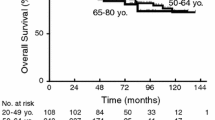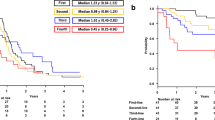Summary
We retrospectively analyzed overall survival and survival after progression in 91 patients with low-grade follicular lymphoma (LGFL). Histological subtype was B in 75 patients and C in 16 patients. Twelve patients with localized disease received involved-field radiotherapy; seven patients without bulky disease had no initial therapy. The remaining 72 patients received long-term chlorambucil (9 patients), MOPP or COPBleo (42 patients), or a CHOP-derived regimen (21 patients). Forty-two patients (46%) achieved a complete remission (CR) and 28 patients (31%) achieved a partial remission; 48 of these 70 patients relapsed or progressed. Nineteen of the other 21 patients with stable LGFL progressed. Two other patients failed to respond and rapidly died. Thirty-two of the 67 patients with progressive or relapsed LGFL have died. Median overall survival was 111 months. Age ≥70 years, male sex, B symptoms, histological subtype follicular mixed-cell NHL, tumor size ≥10 cm, number of extranodal sites of disease ≥2, pleural effusion, and Ann Arbor stage III or IV were found to adversely influence overall survival. Failure-free survival < 24 months, failure to achieve a CR after the progression, initial histological subtype follicular mixed cell, initial Ann Arbor stage III or IV, and initial tumoral size ≥10 cm were found to adversely influence survival after progression. Our results suggest that most prognostic factors for overall survival in LGFL are related to histological subtype or tumor burden. Some initial adverse prognostic factors for survival may be also associated with a poor survival after progression.
Similar content being viewed by others
References
Anderson T (1983) Nodular mixed cell lymphoma: is there a potential for a prolonged disease-free survival and cure? In: Bennett JM (ed) Controversies in the management of lymphomas. Martinus Nijhoff Publishers, Boston, pp 225–237
Anderson T, De Vita VT, Simon RM, et al. (1982) Malignant lymphoma. II. Prognostic factors and response to treatment of 473 patients at the National Cancer Institute. Cancer 50: 2708–2721
Armitage JD, Dick FR, Corder MP (1981) Diffuse histiocytic lymphoma after histologic conversion. A poor prognosis variant. Cancer Treat Rep 65: 413–418
Bennett JM, Cain KC, Glick JH, et al. (1986) The significance of bone marrow involvement in non-Hodgkin's lymphoma: the Eastern Cooperative Oncology Group expericnce. J Clin Oncol 4: 1462–1469
Bosly A, Coiffier B, Gisselbrecht C, Tilly H, Auzanneau G, Andrien F, Herbrecht R, Legros M, Devaux Y, Jaubert J, Pignon B, Michaux JL, Humblet Y, Dupriez B, Thyss A, Lederlin P (1992) Bone marrow transplantation prolongs survival after relapse in aggressive-lymphoma patients treated with LNH-84 regimen. J Clin Oncol 10: 1615–1623
Breslow NE, Day NE (1985) The standardized mortality ratio. In: Sen PK (ed) Biostatistics: statistics in biomedical, public health and environmental scicnces. North-Holland/Elsevier Scicnce Publishers BV, New York, pp 55–74
Carbone PP, Kaplan HS, Musshoff K, Smithers DW, Tubiana M (1971) Report of the committee on Hodgkin's disease staging. Cancer Res 31: 1860–1861
Cheson BD, Wittes RE, Friedman MA (1986) Low-grade non-Hodgkin's lymphomas revisited. Cancer Treat Rep 70: 1051–1054
Coiffier B, Gisselbrecht C, Herbrecht R, Tilly H, Bosly A, Brousse N (1989) LNH-84 regimen: a multicenter study of intensive chemotherapy in 737 patients with aggressive malignant lymphoma. J Clin Oncol 7: 1018–1026
Ersböll J, Schultz HB, Pedersen-Bjergaard J, Nissen NI (1989) Follicular low-grade non-Hodgkin's lymphoma: long-term out-come with or without tumor progression. Eur J Haematol 42: 155–163
Ezdinli EZ, Anderson JR, Melvin F, et al. (1985) Moderate versus aggressive chemotherapy of nudular lymphocytic poorly differentiated lymphoma. J Clin Oncol 3: 769–775
Ezdinli EZ, Harrington DP, Kucuk O, et al. (1987) The effect of intensive intermittent maintenance therapy in advanced low-grade non-Hodgkin's lymphoma. Cancer 60: 156–160
Fouillard L, Gorin NC, Laporte JPh, et al. (1991) Feasibility of autologous bone marrow transplantation for early consolidation of follicular non-Hodgkin's lymphoma. Eur J Haematol 46: 279–284
Freedman AS, Ritz J, Neuberg D, et al. (1991) Autologous bone marrow transplantation in 69 patients with a history of low-grade B-cell non-Hodgkin's lymphoma. Blood 77: 2524–2529
Gallagher CG, Lister TA (1987) Follicular non-Hodgkin's lymphoma. Bailliere's Clin Haematol 1: 141–155
Gallagher CJ, Gregory WM, Jones AE, et al. (1986) Follicular lymphoma: prognostic factors for response and survival. J Clin Oncol 4: 1470–1480
Gospodarowicz MK, Bush RS, Brown TC, et al. (1984) Prognostic factors in nodular lymphomas: a multivariate analysis based on the Princess Margaret Hospital experience. Int J Radiat Oncol Biol Phys 10: 489–497
Gribben JG, Freedman AS, Neuberg D, et al. (1991) Immunologic purging of marrow assessed by PCR before autologous bone marrow transplantation for B-cell lymphoma. N Engl J Med 325: 1525–1533
Gribben JG, Freedman AS, Woo SD, et al. (1991) All advanced-stage non-Hodgkin's lymphomas with a polymerase chain reaction amplifiable breakpoint of bcl-2 have residual cells containing the bcl-2 rearrangement at evaluation and after treatment. Blood 78: 3275–3280
Hochster HS, Kim K, Green MD, et al. (1992) Activity of fludarabine in previously treated non-Hodgkin's low-grade lymphoma: results of an Eastern Cooperative Oncology Group study. J Clin Oncol 10: 28–32
Jones SE (1986) Follicular lymphoma. Do no harm. Cancer Treat Rep 70: 1055–1057
Kaplan ES, Meier P (1958) Nonparametric estimation from incomplete observation. J Am Stat Assoc 53: 452–481
Lennert K (1981) Histopathology of non-Hodgkin's lymphomas (based on the Kiel classification). Springer, Berlin Heidelberg New York
Leonard RCF, Cuzick J, McLennan ICF, et al. (1983) Prognostic factors in non-Hodgkin's lymphoma: the importance of symptomatic stage as an adjunct to the Kiel histopathological classification. Br J Cancer 47: 91–102
Lepage E, Sebban C, Gisselbrecht C, et al. (1990) Treatment of low-grade non-Hodgkin's lymphomas: assessment of doxorubicin in a controlled trial. Hematol Oncol 8: 31–39
Martinsson U, Glimelius B, Hadberg H, Sundstrom C (1988) Prognostic relevance of serum markers in relation to histo-pathology, stage and initial symptoms in advance low-grade non-Hodgkin's lymphomas. Eur J Haematol 40: 289–298
Non-Hodgkin's Lymphoma Pathologic Classification Project (1982) National Cancer Institute-sponsored study of classifications of non-Hodgkin's lymphomas: a summary and description of a working formulation for clinical usage. Cancer 49: 2115–2135
Oviatt DL, Cousar JB, Collins RD, et al. (1984) Malignant lymphomas of follicular center cell origin in human. V. Incidence, clinical features and prognostic implications of transformation of small cleaved cell nodular lymphoma. Cancer 53: 1109–1114
Peto R, Peto J (1972) Asymptotically efficient rank invariant test procedures (with discussion). J R Stat Soc A 135: 185
Portlock CS (1980) Management of the indolent non-Hodgkin's lymphomas. Semin Oncol 7: 292–301
Romaguera JE, McLaughlin P, North L, et al. (1991) Multivariate analysis of prognostic factors in stage-IV follicular low-grade lymphoma: a risk model. J Clin Oncol 9: 762–769
Rosenberg SA (1985) The low-grade non-Hodgkin's lymphomas: challenge and opportunities. J Clin Oncol 3: 299–310
Solal-Celigny P, Lepage E, Brousse N, et al. (1991) Alpha-interferon and chemotherapy in patients with high tumor burden follicular lymphoma. Preliminary results of the “groupe d' etude des lymphomes folliculaires”. Proc Am Soc Clin Oncol (Abstr 955)
Steward WP, Crowther D, McWilliam LJ, et al. (1988) Maintenance chlorambucil after CVP in the management of advanced-stage low-grade histologic type non-Hodgkin's lymphoma. Cancer 61: 441–447
Vita VT De, Serpick AA, Carbone PP (1970) Combination chemotherapy in the treatment of advanced Hodgkin's disease. Ann Intern Med 73: 881
Author information
Authors and Affiliations
Rights and permissions
About this article
Cite this article
Morel, P., Dupriez, B., Plantier-Colcher, I. et al. Long-term outcome of follicular low-grade lymphoma a report of 91 patients. Ann Hematol 66, 303–308 (1993). https://doi.org/10.1007/BF01695972
Received:
Accepted:
Issue Date:
DOI: https://doi.org/10.1007/BF01695972




